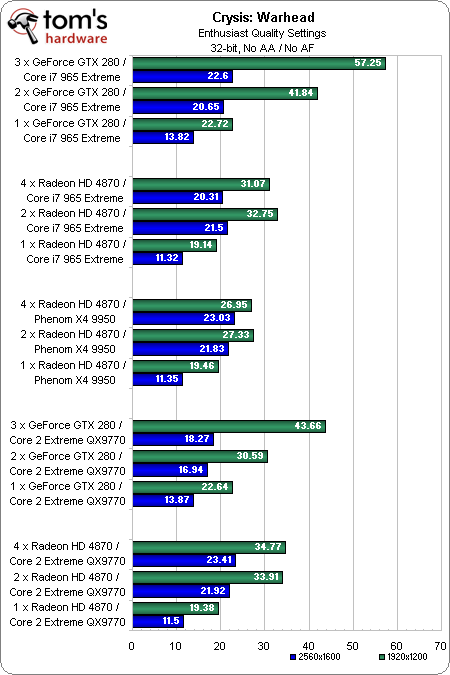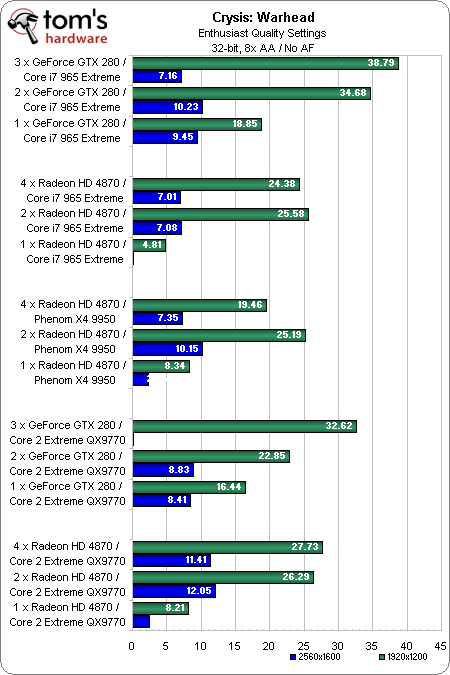Core i7: 4-Way CrossFire, 3-way SLI, Paradise?
Benchmark Results: Crysis: Warhead

Whew. At least most of the tests we ran in Crysis: Warhead move in the right direction as we add graphics horsepower. Without question, Nvidia’s GeForce GTX 280 cards dominate this title, delivering great frame rates with 3-way SLI enabled on the Core i7 965 Extreme.
Unfortunately, the AMD- and Nvidia-based setups all tank at 2560x1600, and in fact, demonstrate very poor scaling moving from two-way CrossFire/SLI to four/three-way CrossFire/SLI. At that resolution, there isn’t a single playable configuration available, it seems. If you’re willing to step back to 1920x1200, though, possibilities begin to open up.

We should have expected as much, but guess what? Turning on anti-aliasing does not, in fact, improve the performance of a test bed full of systems that weren’t running smoothly without it.
The GeForce GTX 280s actually continue performing well on both Intel’s Core 2 Extreme and its Core i7 965 Extreme configurations, approaching playable speeds with three cards installed. At 2560x1600, those same boards struggle to break double-digit frame rates, and even fail outright in the 3-way SLI/Core 2 Extreme QX9770 setup.
Not that the Radeons fare a whole lot better. At 1920x1200, none of our tested configurations are able to break 30 FPS. And at 2560x1600, a single Radeon HD 4870 with 512 MB of GDDR5 is simply unable to cope with the demands being placed on it. Adding memory and a second GPU does help, but not nearly enough to make the higher resolution viable by any means.
It is worth noting that the GeForce GTX 280 gives you better performance on Core i7 versus Core 2, while the Radeon HD 4870s actually sacrifice performance in shifting to Intel’s Nehalem architecture. It’d seem that AMD still has some driver optimization to do in this regard.
Get Tom's Hardware's best news and in-depth reviews, straight to your inbox.
Current page: Benchmark Results: Crysis: Warhead
Prev Page Benchmark Results: Crysis 64-bit Next Page Benchmark Results: Company of Heroes-
DFGum Yep, i hafta say being able to switch brands of graphics cards on a whim and selling off the old is great. Knowing im going to be getting the preformance these cards are capable of (better price to preformance ratio) is nice also.Reply -
cangelini randomizerSLI scales so nicely on X58.Reply
Hey you even got a "First" in there Randomizer! -
randomizer cangeliniHey you even got a "First" in there Randomizer!And modest old me didn't even mention it. :lol:Reply -
enewmen Still waiting for the 4870 X2s to be used in these bechmarks. I thought THG got a couple for the $4500 exteme system. But still happy to see articles like this so early!Reply -
cangelini enewmenStill waiting for the 4870 X2s to be used in these bechmarks. I thought THG got a couple for the $4500 exteme system. But still happy to see articles like this so early!Reply
Go check out the benchmark pages man! Every one with 1, 2, 4 4870s. The 2x and 4x configs are achieved with X2s, too.
Oh, and latest drivers all around, too. Crazy, I know! =) -
enewmen cangeliniI found it, just read the article too quickly. - My bad.Reply
"A single Radeon HD 4870 X2—representing our 2 x Radeon HD 4870 scores—is similarly capable of scaling fan speed on its own. "
Hope to see driver updates like you said. -
spyde Hi there, my question regarding these benchmarks with the HD card is, "was a 2G card use or a 1G". I am about to buy a new system and was looking to buy 2 x HD4870X2 2G cards, but with these results its looking a bit ify. I hope you can answer my question.Reply
Cheers. -
Proximon That's a nice article. I especially like the way the graphs are done. everything is scaled right, and you get an accurate representation.Reply
